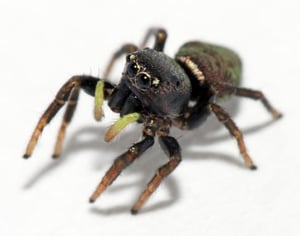.jpg?width=300&name=Wasp%20On%20Branch%20(1).jpg) Do Insects Have Brains?
Do Insects Have Brains?
Do you ever wonder if bugs have brains? What exists in their tiny heads? Most insects have tiny brains, but they don’t work as ours do. Some insects such as cockroaches can live for several days without their heads which isn’t the case for humans. So what are their brains for? In this article, we discuss insect brains and intelligence.
How Do Insect Brains Work?
Insects have tiny brains inside their heads. They also have little brains known as “ganglia” spread out across their bodies. The insects can see, smell, and sense things quicker than us. Their brains help them feed and sense danger faster, which makes them incredibly hard to kill sometimes.
What Are the Three Lobes of an Insect Brain?
An insect’s brain has three main parts, each with its own job:
- Protocerebrum – Handles vision and learning. It’s connected to the eyes and contains mushroom bodies for memory and decision-making.
- Deutocerebrum – Connects to the antennae and processes smells, tastes, temperature, humidity, and touch.
- Tritocerebrum – Links to the mouthparts and internal nerves, helping coordinate the rest of the body.
This structure explains why some insects can survive even after losing their heads.
Are Insects Intelligent?
Studying insect intelligence is tricky, but research shows they can learn, remember, and adapt. Bees, for example, have around 1 million neurons and use mushroom bodies to navigate and solve problems. Ants communicate with scent trails and work together as colonies. Insects that adapt to different foods and environments, like cockroaches, often show more intelligence than specialists like fleas. 
Why Does This Matter?
.jpg?width=300&name=Cricket%20(1).jpg) For insects, what matters is the size of mushroom bodies. This pair of structures found in the protocerebrum is responsible for learning and memory, which implies intelligence. What this would mean is that insects with larger mushroom bodies are more intelligent than those with relatively smaller ones.
For insects, what matters is the size of mushroom bodies. This pair of structures found in the protocerebrum is responsible for learning and memory, which implies intelligence. What this would mean is that insects with larger mushroom bodies are more intelligent than those with relatively smaller ones.
Unfortunately, that isn’t always the case. Bigger brains don’t automatically translate to more intelligence. Scientists argue that generalist insects are smarter than others. The term refers to insects that can adapt to any environment. Think about it.
What becomes of the insect that only knows how to live and feed on one tree or flower? What becomes of this insect when the food source and habitat are suddenly taken away? An animal that ignores its surroundings and lives for one purpose dies if the balance ceases to exist. It’s possible to argue that fleas, for instance, aren’t intelligent insects because they live solely to feed on a host's blood.
A generalist insect, however, is constantly checking its environment for different threats, habitats and food sources. It can be likened to a shrewd investor- always knows how to play his cards and survive. A bee for example, will feed on different flowers until it finds the flowers it should feed on. Ants also display generalist characteristics because they can feed on a variety of plant and animal matter.
What makes these insects more interesting is their social intelligence. Bees and ants live in colonies and are known to leave scent trails for each other. Once a worker finds food, the rest of the colony can follow. Perhaps it’s the socialization of these insects that make them more intelligent. After all, how can the ants and bees ensure that they go home to the right colony?
How Can We Help?
Understanding insects around us helps us predict their behavior and protect your home from an infestation. Contact SafeHaven Pest Control today!








